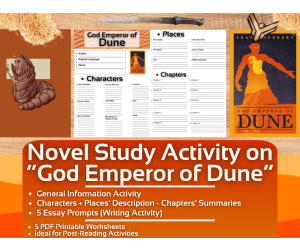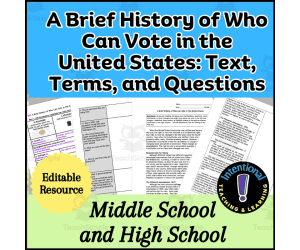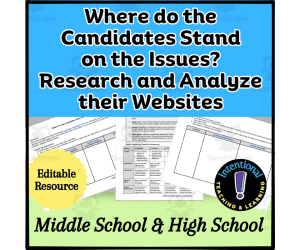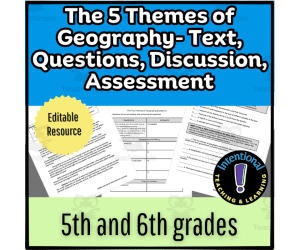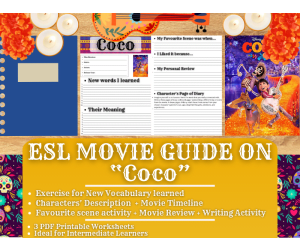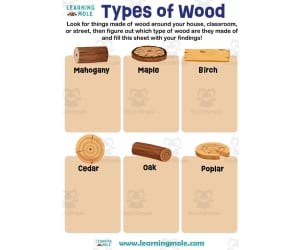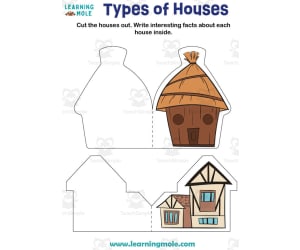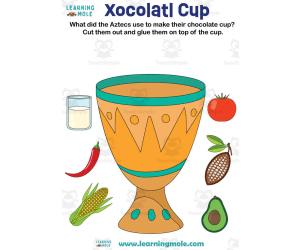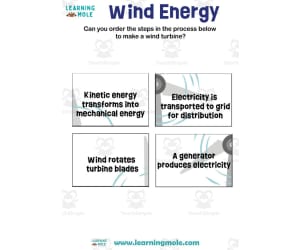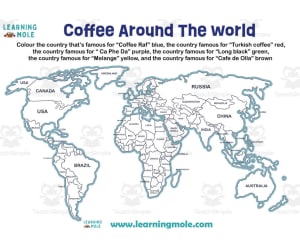4,832 products added recently
Page 324 - Newest Teaching Resources
ESL Reading Comprehension + Essay Worksheets - "El Dia de los Muertos"
ELA, Language Development, ESL, Grade 7, 8, 9, 10, 11, 12, Worksheets & Printables, Worksheets
ESL Reading Comprehension + Essay Worksheets - "El Dia de los Muertos" - Mexico This ESL EFL TESOL Teaching Resource on "El Dia de los Muertos" (3 PDF Slides; Reading Comprehension + Writing Activity ) can be ideal to train Language skills in English. Suitable participants for this ESL EFL TESOL Reading + Writing Activity are Foreign Students at middle and High School (7th-12th Grade; teens). Newcomers or any ESL Learner is also more than suitable for this ESL EFL TESOL Activity on "El Dia de los Muertos" (important celebration in Mexican Culture). This Teaching Educational Resource Product can also be ideal for ESL EFL Centers worldwide or any English second language tutor. This ESL EFL TESOL Teaching Resource on "El Dia de los Muertos" (Worksheet; 3 PDF Printable slides) can be ideal for intermediate English as a Second Language (ESL) Learners. Within this ESL EFL TESOL Reading Comprehension + Essay Writing Activity Worksheet on "El Dia de los Muertos" (important celebration in Mexican Culture), teachers can find the following activities: 1 text on "El Dia de los Muertos" (important celebration in Mexican Culture) 13 text-based Questions (with space for answers) 2 Essay Prompts (pretending to visit Mexico during "El Dia de los Muertos" and to write a page of diary on this experience + writing an essay on a celebration in your home country which similarly to "El Dia de los Muertos" plays a meaningful role in culture and society and that allows elder generations to pass on traditions to younger ones) This ESL, EFL, TESOL Teaching Resource Reading + Writing Activity on "El Dia de los Muertos" (important celebration in Mexican Culture) is great for Intermediate English as a second or foreign language learners (ESL- EFL). This English Second Language Worksheet on "El Dia de los Muertos" (important celebration in Mexican Culture) aims to train and Reading Comprehension + Writing Skills. Learning with Alan is a Teaching Resources and Educational Material Store whose aim is to help English as a Second or foreign Language Teachers, Educators and Tutors worldwide (be it online or offline) to achieve their ESL EFL TESOL TEFL teaching objectives while creating a fun and stimulating environment. Never Forget! Learning is fun, So should English! Always If you want to browse more PDF ESL, EFL, TESOL Teaching Resources and Educational Material click here Learning with Alan!
Author Learning with Alan
Tags ESL, English, English Second Language, Reading Comprehension, Worksheets, Printable, Dia De Los Muertos, Mexico, Mexican, Writing Activity
Novel Study Worksheets - God Emperor of Dune - Frank Herbert - Sci Fi
ELA, Reading, Reading Comprehension, Grade 7, 8, 9, 10, 11, 12, Worksheets, Worksheets & Printables
Novel Study Worksheets - God Emperor of Dune - Frank Herbert - Sci Fi In this fantastic English language and Literature teaching resource it is offered a comprehensive novel study worksheet activity (5 printable PDF pages; Worksheets) focused on the Science Fiction novel "God Emperor of Dune" by American sci fi author Frank Herbert. Perfect for post-reading exercises, this English Language and Literature teaching resource can be more than great to deepen and improve students' understanding of this classic work. The English Novel Study activity (5 printable PDF pages; Worksheets) can be ideal for English class students in middle and high school (from 7th grade to 12th grade, teen students). In this Novel Study on “God Emperor of Dune” (5 printable PDF pages; Worksheets), English Language and Literature teachers can find the following activities: 1 section dedicated on general information (author's name, genre, and original language) 1 section dedicated on character descriptions (9 characters) 1 section dedicated on descriptions of key locations (6 places) 1 section decicated on chapter summaries (59 chapters) 1 section dedicated on a writing activity with 5 essay prompts (book review + 4 other novel related essay prompts) This English Language and Literature Novel Study Activity on "God Emperor of Dune" by American Science Fiction author Frank Herbert (5 PDF Printable Slides; worksheets) can be great for learners from 7th grade to 12th grade to study this Science Fiction Novel (middle school and High School Students mostly) Learning with Alan is a Teaching Resource/Educational Material Store whose aim is to help Teachers, Educators and Tutors to achieve their teaching objectives while creating a fun and stimulating learning and teaching environment. Remember. Learning is Fun. Never Forget! If you want to browse more of my English Language and Literature Novel Study Activity Teaching Resources, click here Learning with Alan!
Author Learning with Alan
Tags Novel Study, English, Worksheets, Printable, Dune, Frank Herbert, Sci Fi, Science Fiction, Books, Book Companion
A Brief History of Who Can Vote in the U.S..-Text, Terms, & Questions
Social Studies, Government, History, History: USA, Grade 7, 8, 9, 10, Teacher Tools, Lesson Plans
It is imperative that our students learn our voting rights history and to help them understand how fundamental voting rights are to a healthy democracy. The 45-page, editable, low-prep resource, A Brief History of Who Can Vote in the United States- Text, Terms, and Questions, provides your middle and high school students with an engaging reading and critical thinking questions that will prompt interesting discussions. The reading provides a short history of voting in the United States starting with The United States Constitution and requirements for voting, continuing with the 15th, 19th 23rd, 24th, and 26th Amendments, the 1965 Voting Rights Act; the 2013 Supreme Court' ruling Shelby v. Holder that struck down key parts of the Voting Rights Act, Voting during the Pandemic in 2020, the 2020 General Election, and new attempts to both expand and restrict voting rights in the 2022 and upcoming 2024 elections. The pdf includes a link to a force copy google doc which you can easily edit to suit your needs. Included in the resource are the following: About this Resource-- a table that includes key information such as the link to the google document so you can make a copy, standards, objectives, learning targets, etc An Essential Question: How has the evolution of voting rights in the United States shaped the nation's democratic principles and institutions? 3 Guiding Questions: 1. What factors have influenced the expansion and restriction of voting rights throughout U.S. history, particularly in relation to race, gender, and socioeconomic status? 2. How have amendments to the U.S. Constitution, such as the 15th, 19th, and 26th Amendments, impacted the extension of voting rights and the empowerment of disenfranchised groups? 3. In what ways does voter suppression persist in modern American society, and what strategies have been employed to combat these efforts, particularly in the wake of the 2020 election? a detailed lesson plan a KWL Chart for students to discuss what they know about voting, elections, the history of voting, etc., what they want to know, and what they learned. An informative and engaging reading presented in two different formats (one with 2-columns for easy annotation, and one with the more traditional one-column). A Tips for Talking to the Text (annotation) Bookmark A short vocabulary activity, critical thinking questions and an answer key. The critical thinking questions invite engaging discussions among students and also requires them to reflect on what they think about the answers to the questions. Interested in more 2024 Presidential Election Resources? Check out these: The U.S. Presidential Election: Anticipation Guide, Questions, Discussion 12 Essential Election Terms for Middle & High School- Vocabulary Strategies 12 Essential Election Terms Color by Number Vocabulary Review for Middle School What are your Political Viewpoints? A Survey for Middle and High School Students Major & Minor Political Parties in US History & Modern Times- Text and Questions A Brief History of Who Can Vote in the United States, Text, Terms, Questions United States Presidential Election Process- Primaries to the Electoral College Propaganda & Political Campaign Ads- Close Viewing Analysis & Written Reflection Where do the Candidates Stand on the Issues? Research and Analyze their Websites Argumentative Letter on a Candidate or Mandatory Voting Presidential Election Project-Collaborative, Creative, & Analytical
Author Intentional Teaching and Learning
Tags Voting Rights, United States History, Social Studies, Government, Elections, Amendments, Voting Suppression, Suffrage, Democracy, Voting
U.S. Presidential Election- Anticipation Guide, Questions, Discussion
Social Studies, Government, History, History: USA, Grade 6, 7, 8, 9, 10, 11, 12, Teacher Tools, Lesson Plans
We want our students to grow up to be civically engaged and participate in our democracy. We want them to become informed voters! This 12-page lesson, U.S. Presidential Election- Anticipation Guide, Questions, Discussion, is a perfect introductory lesson for your 6th to 12th grade students to any unit on the United States Presidential Election and on the United States Constitution. A handy About this Resource includes all the information you need about this lesson: the link to the google doc, an overview, the Essential and Guiding Questions, Objectives, Learning Targets, Standards, list of resources, etc. In addition, the Table of Contents is hyperlinked. Students complete the Anticipation Guide after reading 8 "I know about..." statements about the election. They select Agree or Disagree for each statement based upon their current knowledge. Then they work with a partner or in a small group to find the answers to the statements. For example, "I know how often the United States holds a presidential election." Whether they selected Agree or Disagree, they have to write the answer. For homework, they have to ask a family member of voting age to complete the same assignment. Then the students reflect on this experience. The Essential Question asks students to consider What factors influence our understanding of the upcoming election, and how can we critically evaluate our knowledge to become more informed participants in the democratic process? The 2 Guiding Questions guide students to probe deeper: What criteria can we use to assess the accuracy, relevance, and completeness of our current understanding of the upcoming elections? How can we identify gaps in our knowledge about the election process, candidates' platforms, and key issues, and what strategies can we employ to address these gaps effectively? The Objectives include students identifying how much they know about the upcoming general election and then asking an adult in their family to identify how much they know. The detailed lesson plan includes History Standards as well as standards related to discussions. In addition, the Essential Statements about the Election require students to reflect on what they know and what they don't know about the presidential election. Once completed, students collaborate on checking their answers and finding the correct responses to the questions. Then students will ask an adult in their family or community the same questions. Even if the person they are questioning isn't a voter for whatever reason, your students and their family or community member will learn from this activity. Finally, they will briefly reflect on what they learned from this activity. Whether you choose to use more of my lessons on the election (see below) or add this one lesson to your arsenal of lessons, your students will find this lesson both engaging and intellectually stimulating. Interested in more 2024 Presidential Election Resources? Check out these: The U.S. Presidential Election: Anticipation Guide, Questions, Discussion 12 Essential Election Terms for Middle & High School- Vocabulary Strategies 12 Essential Election Terms Color by Number Vocabulary Review for Middle School What are your Political Viewpoints? A Survey for Middle and High School Students Major & Minor Political Parties in US History & Modern Times- Text and Questions A Brief History of Who Can Vote in the United States, Text, Terms, Questions United States Presidential Election Process- Primaries to the Electoral College Propaganda & Political Campaign Ads- Close Viewing Analysis & Written Reflection Where do the Candidates Stand on the Issues? Research and Analyze their Websites Argumentative Letter on a Candidate or Mandatory Voting Presidential Election Project-Collaborative, Creative, & Analytical
Author Intentional Teaching and Learning
Tags U.S. Presidential Election, 2024 Election, Anticipation Guide, Discussion, Presidential Election Facts, Politics, Civics, Government, Voting, Civic Engagement
Argumentative Letter on a Candidate or Mandatory Voting
Social Studies, ELA, Government, History, History: USA, Writing, Grade 7, 8, 9, Teacher Tools, Lesson Plans
The low-prep, 27-page resource, Argumentative Letter on a Candidate or Mandatory Voting has your middle and high school students take a position on either which presidential candidate to support or whether voting should be mandatory in the United States, write a 4-paragraph argumentative letter to the editor, and then send them off to online sites that accept letters to the editors, such as local, state, or national news sites. I have included links to four online articles that address the pros and cons of making voting mandatory in the United States that the students can use for their research. If your students choose to do the candidate letter, this lesson works best if students have done my lesson, Where the Candidates Stand on the Issues or something similar to that. This lesson doesn’t specifically teach how to write an argumentative essay. It builds on what students already know, assuming they have already written argumentative essays. Embedded in this lesson are a brainstorming activity for evidence and analysis, a template for writing the essay, a graphic organizer all of which provide scaffolded support to your diverse range of writers, and a rubric. Argumentative Letter on a Candidate or Mandatory Voting includes the following: a hyperlinked Table of Contents About this Resource-- an easy-to-use guide to everything you need to know about this resource a forced link copy to the Google Doc Common Core Literacy Standards for Writing in History Objectives and Learning Targets An Essential Question for Each Prompt: For the Candidate Letter to the Editor: What key qualities and policies make one presidential candidate more suitable than another? For the Mandatory Voting Letter to the Editor: Should voting be mandatory in a democratic society? 3 Guiding Questions for Each Prompt: For the Candidate Letter to the Editor: What are the major policy differences between the two candidates? How do the candidates' backgrounds and experiences shape their suitability for the presidency? Which candidate's proposed solutions do you believe are more effective in addressing current societal challenges? For the Mandatory Voting Letter to the Editor: What are the arguments for and against mandatory voting? How does mandatory voting affect voter turnout and representation? What are the potential benefits and drawbacks of implementing mandatory voting laws? Student Handouts: Evidence/Analysis Matrix for Candidates Argumentative Essay Evidence Analysis Matrix for Mandatory Voting Argumentative Essay Candidate Argumentative Essay Prompt Mandatory Voting Argumentative Essay Prompt Template for Candidate Argumentative Essay Prompt Template for Mandatory Voting Argumentative Essay Prompt Verbs and Transition Words and Phrases for Argumentative Writing Graphic Organizer for Argumentative Essay Argumentative Essay Rubric: Portrait and Landscape Format Interested in more 2024 Presidential Election Resources? Check out these: The U.S. Presidential Election: Anticipation Guide, Questions, Discussion 12 Essential Election Terms for Middle & High School- Vocabulary Strategies 12 Essential Election Terms Color by Number Vocabulary Review for Middle School What are your Political Viewpoints? A Survey for Middle and High School Students Major & Minor Political Parties in US History & Modern Times- Text and Questions A Brief History of Who Can Vote in the United States, Text, Terms, Questions United States Presidential Election Process- Primaries to the Electoral College Propaganda & Political Campaign Ads- Close Viewing Analysis & Written Reflection Where do the Candidates Stand on the Issues? Research and Analyze their Websites Argumentative Letter on a Candidate or Mandatory Voting Presidential Election Project-Collaborative, Creative, & Analytical
Author Intentional Teaching and Learning
Tags Presidential Elections, Argumentative Letter, Presidential Candidates, Cross-curricular, Critical Thinking, Claims And Counterclaims, Evidence And Analysis, Mandatory Voting, Rubric, Middle And High School;
Presidential Election Project-Collaborative, Creative, & Analytical
Social Studies, Government, History, History: USA, Research, Grade 6, 7, 8, 9, Projects, Activities
Invigorate your classroom and excite your middle and high school students with the easy-prep and creative 22-page resource, Presidential Election Project-Collaborative, Creative, & Analytical. Students will use their collaborative, analytical, and creative skills to research and create a presentation about the two major-party candidates running for president. (It would be easy to add a third-party candidate as well.) Complete with two lessons, the resource provides teachers and students everything they need to create a unique and interesting group project, including possible ideas they might want to consider, such as two cereal boxes devoted to the candidates with an ad, superhero dolls and a skit, debate, etc. In addition, there is an interactive lesson on what it means to collaborate in a group project with students coming up with descriptive behaviors of what engaging group work looks like, sounds, like, and feels like. The project will take about 5-7 days to complete before presentation . Presidential Election Project-Collaborative, Creative, & Analytical includes the following: a hyperlinked Table of Contents About this Resource-- an easy-to-use guide to everything you need to know about this resource a forced link copy to the Google Doc Common Core Literacy Standards in Reading Informational Text and Speaking and Listening Objectives and Learning Targets Essential Question: How can we effectively and creatively analyze and present information about the candidates for the presidential election to inform and engage our audience? 3 Guiding Questions: What are the key qualifications and characteristics that voters typically consider when evaluating presidential candidates? How do the policies and platforms of the different candidates align with the concerns and interests of various demographic groups in our society? What creative strategies can we use to present our analysis of the candidates in an engaging and informative way to our classmates? Resource for the Teacher and Students: What are the key qualifications and characteristics that voters typically consider when evaluating presidential candidates? How do the policies and platforms of the different candidates align with the concerns and interests of various demographic groups in our society? What creative strategies can we use to present our analysis of the candidates in an engaging and informative way to our classmates?2 Lesson Plans: Election Group Project and Collaborative Group Work Collaborative Group Work Example and Blank Copy Election Group Project Student Directions Election Group Project Presentation Rubric Brainstorming for your Project: The Issues and where the Candidates Stand Election Group Project Daily Accountability for Homework and Classwork Individual Group Project Reflection Interested in more 2024 Presidential Election Resources? Check out these: The U.S. Presidential Election: Anticipation Guide, Questions, Discussion 12 Essential Election Terms for Middle & High School- Vocabulary Strategies 12 Essential Election Terms Color by Number Vocabulary Review for Middle School What are your Political Viewpoints? A Survey for Middle and High School Students Major & Minor Political Parties in US History & Modern Times- Text and Questions A Brief History of Who Can Vote in the United States, Text, Terms, Questions United States Presidential Election Process- Primaries to the Electoral College Propaganda & Political Campaign Ads- Close Viewing Analysis & Written Reflection Where do the Candidates Stand on the Issues? Research and Analyze their Websites Argumentative Letter on a Candidate or Mandatory Voting Presidential Election Project-Collaborative, Creative, & Analytical
Author Intentional Teaching and Learning
Tags Presidential Election, Collaboration, Group Project, Self-reflection, Research, Creativity, Presentation, Analysis, Rubric, Current Events
Propaganda & Political Campaign Ads- Close Viewing Analysis & Writing
Social Studies, Government, History, History: USA, Grade 7, 8, 9, 10, 11, 12, Teacher Tools, Lesson Plans
Updated for the 2024 Election! Propaganda and Political Campaign Ads- Close Viewing Analysis and Written Reflection is a 35-page, low-prep and fascinating lesson that both you and your students will enjoy. In this lesson, students are introduced to the concept of propaganda and how politicians use propaganda, particularly through campaign ads, to influence voters. Students will be able to explain what propaganda is, why it’s important to know what propaganda is, how politicians use propaganda in their campaign ads, and how effective they think the message is in those ads. This lesson includes an “into” activity, a “through” close viewing and analysis of campaign ads, and a “beyond” writing assessment . To get the students into the lesson, students will explore the word propaganda. Then they will analyze several 2020 presidential campaign ads. Finally, they will write about their conclusions. The lesson includes the following: a hyperlinked Table of Contents About this Resource which includes a forced link copy to the Google doc which you can edit to serve your needs Detailed Lesson Plan with standards, objectives and learning targets Essential Question: How do propaganda techniques influence public opinion in political campaign ads? 3 Guiding Questions: What are some common propaganda techniques used in political campaign ads, and how do they impact viewers' perceptions of the candidates? How do the messaging and visual elements of Kamala Harris''s ads differ from those of Donald Trump's ads, and what might these differences reveal about their respective campaign strategies? In what ways do Kamala Harris''s and Donald Trump's ads appeal to different demographics or voter groups, and how does this contribute to the overall effectiveness of their campaigns? Propaganda Word Study Four Types of Propaganda Used in Campaign Ads Close Viewing Analyzing Campaign Ads of 3 of Kamala Harris's 2024 campaign ads and 3 of Donald Trump's 2024 campaign ads Propaganda and Political Campaign Ads Writing Assessment Writing Assessment Rubric (landscape and portrait mode) R.A.C.E.S poster for analytical writing Are you interested in more 2024 Election Resources? Check out these: The U.S. Presidential Election: Anticipation Guide, Questions, Discussion 12 Essential Election Terms for Middle & High School- Vocabulary Strategies 12 Essential Election Terms Color by Number Vocabulary Review for Middle School What are your Political Viewpoints? A Survey for Middle and High School Students Major & Minor Political Parties in US History & Modern Times- Text and Questions A Brief History of Who Can Vote in the United States, Text, Terms, Questions United States Presidential Election Process- Primaries to the Electoral College Propaganda & Political Campaign Ads- Close Viewing Analysis & Written Reflection Where do the Candidates Stand on the Issues? Research and Analyze their Websites Argumentative Letter on a Candidate or Mandatory Voting Presidential Election Project-Collaborative, Creative, & Analytical
Author Intentional Teaching and Learning
Tags Presidential Election, Propaganda Word Study, Propaganda Techniques, Political Campaign Ads, Analysis, Persuasive Techniques, Card Stacking Name Calling, Pinpointing The Enemy, Reflective Writing Assessment, Democracy
Where do the Candidates Stand on the Issues? Website Research
Social Studies, Government, History, History: USA, Grade 6, 7, 8, 9, 10, Teacher Tools, Lesson Plans
Where do the Candidates Stand on the Issues? Website Research and Analysis is a 23-page interactive and engaging lesson plan for middle school and high school students as they study the upcoming presidential election. The purpose of the lesson is for students to analyze the differences between the two major party candidates running for president by having them explore each of the candidates’ websites as well as a third website that shows their different perspectives on key issues. In addition, students will also explore 1 third-party candidate’s website. Working in small groups or with a partner, students will explore each of the candidates' websites and will analyze and assess them based on the following: how visually appealing they are; how easy the content is for them to read or view; which coalitions or groups support the candidates; how they present their positions and goals; etc. The assessment is a 5-6 paragraph essay in which they analyze and present their opinions on which website does a better job of presenting their information and why. The detailed lesson plan includes a rubric and a graphic organizer to scaffold the writing process for struggling writers, ELL and RSP students. If you want your students to write an argumentative essay on which candidate to vote for, check out my resource, Argumentative Letter on a Candidate or Mandatory Voting and for a creative collaborative group project, check out my resource, Presidential Election Project-Collaborative, Creative, & Analytical The lesson plan includes the following: a hyperlinked Table of Contents About this Resource: a table that places key information in one place at the beginning of the resource the pdf includes a forced copy link to the Google Doc so you can edit the lesson an Essential Question: 3 Guiding Questions: Standards, Objectives, and Learning Targets The following handouts: Where Do the Candidates Stand on the Issues? 1. About the Candidates: 2. Coalitions: 3. Where the Candidates Stand on the Issues: 4. Information from a Nonpartisan Website: 5. Third Party Candidate Final Thoughts: Explaining Website Preferences Rubric: Explaining Website Preferences Explaining Website Preferences Graphic Organizer Are you interested in more 2024 Election Resources? Check out these: The U.S. Presidential Election: Anticipation Guide, Questions, Discussion 12 Essential Election Terms for Middle & High School- Vocabulary Strategies 12 Essential Election Terms Color by Number Vocabulary Review for Middle School What are your Political Viewpoints? A Survey for Middle and High School Students Major & Minor Political Parties in US History & Modern Times- Text and Questions A Brief History of Who Can Vote in the United States, Text, Terms, Questions United States Presidential Election Process- Primaries to the Electoral College Propaganda & Political Campaign Ads- Close Viewing Analysis & Written Reflection Where do the Candidates Stand on the Issues? Research and Analyze their Websites Argumentative Letter on a Candidate or Mandatory Voting Presidential Election Project-Collaborative, Creative, & Analytical
Author Intentional Teaching and Learning
Tags Election, Website Analysis, Candidates' Positions, Critical Thinking, Research, Civic Engagement, Media Literacy, Analytical Essay, Rubric, Scaffolded Writing
Letter Y Phonics and Writing Centers with Real Photographs
ELA, Language Development, Phonics, Writing, Handwriting, Kindergarten, Preschool, Centers, Activities
This letter Y beginning sounds and handwriting activity includes real photographs to practice learning to recognize, write and identify the sound of the letter Y. Each picture has bold colors and includes easily recognized pictures. Each activity can be used in a literacy center for students to practice letter recognition. What is Included: There is an instructional page with printing instructions. There are letter Y posters with various letter W words. There are handwriting task cards that allow students to practice writing the letter Y as well as words that begin with the letter Y. There are beginning sound clip cards that allow students to practice clipping the images that begin with the letter Y. There is a sorting activity where you sort pictures that begins with Y from words that do not begin with Y. The letter Y sorting cards that can also be used to play memory, matching, or concentration games. These cards can also be used during a lesson in a pocket chart as well as for a center display. When to Use: All of the activities make great literacy centers, by placing each set of activities in the center and letting students complete activities alone or with a partner. These activities make great morning tub activities. Just place these activities in morning bins for students to complete as their classmates arrive to class. Skills Assessed: These activities assess letter recognition skills, beginning sounds, handwriting, and sorting skills. Each activity in this set is low prep. Each activity just needs to be printed out, cut apart, and laminated if desired. When you laminate the writing cards, you can create a writing center activity that is reusable is you add dry erase markers. The handwriting cards and beginning sound clip cards can be turned into task box activities.
Author The Connett Connection
Tags Phonics, Writing Centers, Real Photographs, Early Literacy, Letter Y
5 Themes of Geography- 5th-6th grades Text, Questions, Assessment
Social Studies, Geography, Grade 5, 6, Assessments, Teacher Tools
Introduce your students to The Five Themes of Geography- Text, Questions, Discussion, and Assessment for 5th and 6th grades, a 67-page resource which gets your students reading, writing, discussing, and critically thinking as they learn about the importance of the 5 Themes of Geography-- location, place, movement, interaction, and region. This lesson pairs nicely with my other 5 Themes of Geography lessons, especially The Five Themes of Geography- Text, Questions, Discussion, and Assessment for 7th and 8th grades. Your ELL, RSP, 504, and other students who may be struggling with reading can use the 5th-6th grade lesson and the rest of your class can use the 7th-8th grade lesson. Although there are some differences in the questions, review, and test, the students are essentially receiving the same information tailored to their reading comprehension needs. The resource includes the following- a link to a force copy google doc so you can edit it to meet your needs About this Resource- a handy guide that orients you, the teacher, to everything in the resource a hyper-linked Table of Contents a standards-aligned detailed lesson plan with objectives and learning targets essential and guiding questions an engaging reading with 3 different formats for the text: a two-column layout of text and questions, a one-column layout with embedded questions, and a one-column layout with a question sheet which students can read and discuss with a partner, or a small group. a 15-word crossword puzzle to reinforce vocabulary. an Interactive Notebook assignment in which students explain each of the themes in their own words and explore their personal connections to each of the themes a comprehensive collaborative review and study guide. a summative assessment which consists of multiple choice, true and false questions as well as real-world incidents in which students have to identify which theme the scenario is and explain why it is that theme All assignments include answer keys. Your students will be well-informed after completing this lesson, and teachers will be able to connect the five themes to their 5th and 6th grade social studies curriculums. Based on the California State Standards for Social Students In 5th grade: the Five Themes can be woven into your curriculum to examine the geographical factors that influenced early American history to Westward Expansion by analyzing: Native Americans Before European Exploration: Study how different tribes adapted to and interacted with their environments, such as how the Plains tribes relied on buffalo and how coastal tribes utilized ocean resources. European Exploration and Colonization: Examine how geographical factors, like the location of rivers and fertile land, influenced the establishment and development of the original thirteen colonies. American Revolution: Explore how geography played a role in key battles and strategies, such as the significance of the Appalachian Mountains and the Atlantic coastline. Westward Expansion: Analyze how physical features, such as the Mississippi River and the Rocky Mountains, impacted settlement patterns, economic activities, and interactions with Native American tribes. In 6th grade, the Five Themes can be woven into your curriculum to examine the geographical factors that influenced the development of Early Humans, and the Ancient River Civilizations: Ancient Mesopotamia, Ancient Egypt, and Ancient India, among others. Early Humans: Study how the environment influenced the migration, settlement, and survival strategies of early humans, including the use of tools and the development of agriculture. Ancient Mesopotamia: Examine how the Tigris and Euphrates rivers supported the growth of early cities and influenced human-environment interaction through irrigation and farming. Ancient Egypt: Explore how the Nile River's location influenced Egyptian civilization, including agriculture, trade, and cultural development. Ancient India: Analyze how the Indus and the Ganges Rivers and the monsoon climate affected the development of of early Indian civilizations.
Author Intentional Teaching and Learning
Tags 5 Themes Of Geography 5th Grade, 5 Themes Of Geography 6th Grade, Reading Comprehension, Assessment, Critical Thinking, Discussion, Text And Questions, Crossword Puzzle, Geography, Lesson Plan
Letter X Phonics and Writing Centers with Real Photographs
ELA, Language Development, Phonics, Writing, Handwriting, Kindergarten, Preschool, Centers, Activities
This letter X beginning and ending sounds and handwriting activity includes real photographs to practice learning to recognize, write and identify the sound of the letter X. Each picture has bold colors and includes easily recognized pictures. Each activity can be used in a literacy center for students to practice letter recognition. What is Included: There is an instructional page with printing instructions. There are letter X posters with various letter X words. There are handwriting task cards that allow students to practice writing the letter X as well as words that end with the letter X. There are beginning sound clip cards that allow students to practice clipping the images that begin with the letter X. There is a sorting activity where you sort pictures that end with X from words that do not end with X. The letter X sorting cards that can also be used to play memory, matching, or concentration games. These cards can also be used during a lesson in a pocket chart as well as for a center display. When to Use: All of the activities make great literacy centers, by placing each set of activities in the center and letting students complete activities alone or with a partner. These activities make great morning tub activities. Just place these activities in morning bins for students to complete as their classmates arrive to class. Skills Assessed: These activities assess letter recognition skills, beginning/ending sounds, handwriting, and sorting skills. Each activity in this set is low prep. Each activity just needs to be printed out, cut apart, and laminated if desired. When you laminate the writing cards, you can create a writing center activity that is reusable is you add dry erase markers. The handwriting cards and beginning sound clip cards can be turned into task box activities.
Author The Connett Connection
Tags Phonics, Writing Centers, Real Photographs, Early Literacy, Letter X
ESL Movie Guide Worksheets on Coco
ELA, Language Development, ESL, Grade 6, 7, 8, Worksheets & Printables, Worksheets
ESL Movie Guide Worksheets on Coco This ESL teaching resource is a 3-page printable PDF movie guide for "Coco" (2017 animated film set in Mexico during el Dia de los Muertos) designed to support English as a Second Language (ESL) learners. This resource can be great for post-movie activities and is ideal for middle school students, ranging from 6th to 8th grade. It's a versatile tool suitable for newcomers and any English language learners, making it an excellent choice to use in ESL classrooms, language centers, or by tutors worldwide. This "Coco" (2017 animated film set in Mexico during el Dia de los Muertos) movie guide is ideal for intermediate ESL students. It provides a structured way for learners to engage with the film while developing their English language skills. The guide includes several activities that encourage students to interact with the movie's content in meaningful ways: A section for general information about "Coco" (2017 animated film set in Mexico during el Dia de los Muertos) such as the film's director, genre, and other key details. A space for new vocabulary learned while watching the movie, helping students expand their English lexicon. A part dedicated to describing the main characters, allowing students to practice descriptive language and character analysis. A movie timeline activity where students arrange scenes from the film in chronological order, enhancing their understanding of the narrative structure. A section for students to describe their favorite scene from the movie and explain why they liked it, fostering personal connection and critical thinking. A movie review segment where students can express their opinions about the film, practicing persuasive and evaluative writing. A creative writing task where students imagine themselves as one of the characters and write three diary entries from that character’s perspective, encouraging deeper engagement with the characters and plot. This "Coco" (2017 animated film set in Mexico during el Dia de los Muertos) movie guide is designed to create an enjoyable and stimulating learning experience for intermediate ESL learners. Learning with Alan is a Teaching Resources Store whose aim is to help English as a Second or foreign Language (ESL EFL) Teachers, Educators and Tutors around the world (be it online or offline) to achieve their teaching objectives while creating an enjoyable and stimulating learning environment. Never Forget! Learning is fun, So should English! Always If you want to browse more of my ESL, EFL, TESOL Teaching Resources, click here Learning with Alan!
Author Learning with Alan
Tags ESL, English Second Language, English, Film, Movie Guides, Coco, Mexico, Mexican, Dia De Los Muertos, Writing Activity
Letter W Phonics and Writing Centers with Real Photographs
ELA, Language Development, Phonics, Writing, Handwriting, Kindergarten, Preschool, Centers, Activities
This letter W beginning sounds and handwriting activity includes real photographs to practice learning to recognize, write and identify the sound of the letter W. Each picture has bold colors and includes easily recognized pictures. Each activity can be used in a literacy center for students to practice letter recognition. What is Included: There is an instructional page with printing instructions. There are letter W posters with various letter W words. There are handwriting task cards that allow students to practice writing the letter W as well as words that begin with the letter W. There are beginning sound clip cards that allow students to practice clipping the images that begin with the letter W. There is a sorting activity where you sort pictures that begins with W from words that do not begin with W. The letter W sorting cards that can also be used to play memory, matching, or concentration games. These cards can also be used during a lesson in a pocket chart as well as for a center display. When to Use: All of the activities make great literacy centers, by placing each set of activities in the center and letting students complete activities alone or with a partner. These activities make great morning tub activities. Just place these activities in morning bins for students to complete as their classmates arrive to class. Skills Assessed: These activities assess letter recognition skills, beginning sounds, handwriting, and sorting skills. Each activity in this set is low prep. Each activity just needs to be printed out, cut apart, and laminated if desired. When you laminate the writing cards, you can create a writing center activity that is reusable is you add dry erase markers. The handwriting cards and beginning sound clip cards can be turned into task box activities.
Author The Connett Connection
Tags Phonics, Writing Centers, Real Photographs, Early Literacy, Letter W
ESL Reading Comprehension + Writing Activity Worksheet - Homeschooling
ELA, Language Development, ESL, Grade 7, 8, 9, 10, 11, 12,
ESL Reading Comprehension + Writing Activity Worksheet - Homeschooling This ESL EFL TESOL Teaching Resource on Homeschooling (3 PDF Slides; Reading Comprehension + Writing Activity ) can be ideal to train Language skills in English. Suitable participants for this ESL EFL TESOL Reading + Writing Activity are Foreign Students at middle and High School (7th-12th Grade; teens). Newcomers or any ESL Learner is also more than suitable for this ESL EFL TESOL Activity on Homeschooling (background, what it consists of and pros and cons). This Teaching Educational Resource Product can also be ideal for ESL EFL Centers worldwide or any English second language tutor. This ESL EFL TESOL Teaching Resource on HomeSchooling (Worksheet; 3 PDF Printable slides) can be ideal for intermediate English as a Second Language (ESL) Learners. Within this ESL EFL TESOL Reading Comprehension + Essay Writing Activity Worksheet on Homeschooling (background, what it consists of and pros and cons), teachers can find the following activities: 1 text on Homeschooling (background, what it consists of and pros and cons) 10 text-based Questions (with space for answers) 1 Essay Writing Activity Prompt (writing an essay on your own personal opinion on homeschooling, whether you agree or not) This ESL, EFL, TESOL Teaching Resource Reading + Writing Activity on Homeschooling (background, what it consists of and pros and cons) is great for Intermediate English as a second or foreign language learners (ESL- EFL). This English Second Language Worksheet on Homeschooling (background, what it consists of and pros and cons) aims to train and Reading Comprehension + Writing Skills. Learning with Alan is a Teaching Resources and Educational Material Store whose aim is to help English as a Second or foreign Language Teachers, Educators and Tutors worldwide (be it online or offline) to achieve their ESL EFL TESOL TEFL teaching objectives while creating a fun and stimulating environment. Never Forget! Learning is fun, So should English! Always If you want to browse more PDF ESL, EFL, TESOL Teaching Resources and Educational Material click here Learning with Alan!
Author Learning with Alan
Tags ESL, English, English Second Language, Reading Comprehension, Writing Activity, Essay, Homeschooling, Worksheets, Printable, Activity
Types of Wood Activity
Science, Earth and Environmental Sciences, Life Sciences, Nature & Plants, Grade 3, 4, 5, 6, 7, 8, 9, Activities
Activity Introduction An amazing activity designed for the students to learn more about STEM. Coffee Around The World Do you like STEM subjects? what is your favorite one? Have you ever tried to plant a seed? If yes, tell us more about it. Or have you ever tried to invent something? If yes, tell us more about it. And how do you think it will help us? Have you ever seen a microorganism under a microscope? What was it? And how it looked like? Mathematics is a marvelous subject. Let' sharpen our brains and solve some equations. Do you like timetable tricks? What is your favorite one? Do you know how to code? Have you ever created an app or a game before? If yes, how was it like? Coffee Around The World Activity The activity is perfect for encouraging the researching skills for the students, while learning more about this fantastic topic. Coffee Around The World This friendly designed worksheet is suitable for students at school, homeschooling, and as a group activity. Instructions Look for things made of wood around your house, classroom, or street, then figure out which type of wood are they made of and fill this sheet with your findings! Format Available in a PDF format.
Author Educational Voice
Tags Types Of Wood Activity, Types Of Wood, Wood Activity, Wood Facts, Wood, Wood Facts For Kids, Science, Science Facts, Science Facts For Kids
Types of Houses Activity
Social Studies, Geography, Grade 3, 4, 5, 6, 7, 8, 9, Activities
Activity Introduction An amazing activity designed for the students to learn more about famous houses types in different countries. Types of Houses What do you know about these houses? Where are these houses? Who were the first people to build it? How does your house look like? Can you draw it? Do you have a favourite kind of houses? Tell us more about it. What are the colours of your house or your dream house? Do you like reading about Geography? What is your favorite country in the whole world? Types of Houses Activity The activity is perfect for encouraging the researching skills for the students, while learning more about this fantastic houses. Types of Houses This friendly designed worksheet is suitable for students at school, homeschooling, and as a group activity. Instructions Cut the houses out. Write interesting facts about each house inside. Format Available in a PDF format.
Author Educational Voice
Tags Types Of Houses Activity, Types Of Houses, House, Houses, Geography, Geography Facts, Geography Facts For Kids, Houses Facts, Houses Facts For Kids
Different Types of Houses Activity
Social Studies, Geography, Grade 3, 4, 5, 6, 7, 8, 9, Activities
Activity Introduction An amazing activity designed for the students to learn more about famous houses types in different countries. Different Types of Houses What do you know about these houses? Where are these houses? Who were the first people to build it? How does your house look like? Can you draw it? Do you have a favourite kind of houses? Tell us more about it. What are the colours of your house or your dream house? Do you like reading about Geography? What is your favorite country in the whole world? Different Types of Houses Activity The activity is perfect for encouraging the researching skills for the students, while learning more about this fantastic houses. Different Types of Houses This friendly designed worksheet is suitable for students at school, homeschooling, and as a group activity. Instructions Cut all the cards out and glue them on the right type of house. Format Available in a PDF format.
Author Educational Voice
Tags Different Types Of Houses, Different Types Of Houses Activity, Types Of Houses, Types Of Houses For Kids, Geography, Geography Facts, Geography Facts For Kids, Houses, House
Civics and Government 3rd Grade (15 Day) Unit
Social Studies, ELA, Government, Reading, Writing, Common Core, Grade 3, Lesson Plans, Teacher Tools
Are you introducing 3rd graders to the concept of government and its role in our communities? Through engaging activities, students will explore the differences among national, state, and local and state governments, understand the importance of laws and justice, and learn how governments function to serve the people. This 15 day mini unit includes day by day planning with suggested activities for differentiation. Typically used in a high ability classroom, it is appropriate for all students. Teaching methods used: Jigsaw learning, foldables, Nonfiction research, doodle notes, graphic organizers, group work, individual work, (suggested) guest speakers, and traditional assessment. Unit includes: Alignment page showing 3rd grade social studies state standards, Common Core Reading and Writing standards, and National Council of Social Studies Themes 15 day lesson plan broken into standard, reading/information source, and activities Vocabulary journal + answer key Jigsaw activity for three branches of government Foldable activity for civic virtues Sequencing activity for election process 7 nonfiction reading passages (+ answer keys) 2 Project Based Learning projects - Elect a Mayor and Design a City Rubrics for all projects and answer keys where applicable Traditional vocabulary quiz List of possible guest speakers Government focus: Since third grade is more community based, the content and projects focus mainly on state and local government. The branches of government and responsibilities of important people within the government include national organizations and expectations (i.e.: President, Congress, and Supreme Court). If it is an election year, the election activity can easily be adjusted to "Elect a President" instead of "Electing a Mayor." Tags: government, elections, legislative, executive, judicial, state and local government, city planning, citizen, civic duty, mayor File Type: PDF (not editable) Number of Pages: 53 (including curriculum plan and answer keys) Grade: 3 - depending on state standards, may overlap with second or fourth grade government content
Author Kel's Klass
Tags Government, Elections, Legislative, Executive, Judicial, State And Local Government, City Planning, Citizen, Civic Duty, Mayor
Aztec Chocolate Activity
Science, Earth and Environmental Sciences, Life Sciences, Nature & Plants, Grade 2, 3, 4, 5, 6, 7, 8, 9, Activities
Activity Introduction An amazing activity designed for the students to learn more about STEM subjects. Aztec Chocolate Do you like STEM subjects? what is your favorite one? Have you ever tried to plant a seed? If yes, tell us more about it. Or have you ever tried to invent something? If yes, tell us more about it. And how do you think it will help us? Have you ever seen a microorganism under a microscope? What was it? And how it looked like? Mathematics is a marvelous subject. Let' sharpen our brains and solve some equations. Do you like timetable tricks? What is your favorite one? Do you know how to code? Have you ever created an app or a game before? If yes, how was it like? Aztec Chocolate Activity The activity is perfect for encouraging the researching skills for the students, while learning more about this fantastic plant. Aztec Chocolate This friendly designed worksheet is suitable for students at school, homeschooling, and as a group activity. Instructions What did the Aztecs use to make their chocolate cup? Cut them out and glue them on top of the cup. Format Available in a PDF format.
Author Educational Voice
Tags Aztec Chocolate Activity, Aztec Chocolate, Chocolate, Chocolate Facts, Chocolate Facts For Kids, Chocolate Activity, STEM, Cocoa
Wind Energy Activity
Science, Earth and Environmental Sciences, Environmental Science, Grade 3, 4, 5, 6, 7, 8, 9, Activities
Activity Introduction An amazing activity designed for the students to learn more about STEM subjects. The Wind Energy Do you like STEM subjects? what is your favorite one? Have you ever tried to plant a seed? If yes, tell us more about it. Or have you ever tried to invent something? If yes, tell us more about it. And how do you think it will help us? Have you ever seen a microorganism under a microscope? What was it? And how it looked like? Mathematics is a marvelous subject. Let' sharpen our brains and solve some equations. Do you like timetable tricks? What is your favorite one? Do you know how to code? Have you ever created an app or a game before? If yes, how was it like? Wind Energy Activity The activity is perfect for encouraging the researching skills for the students, while learning more about this topic. Wind Energy This friendly designed worksheet is suitable for students at school, homeschooling, and as a group activity. Instructions Can you order the steps in the process below to make a wind turbine? Format Available in a PDF format.
Author Educational Voice
Tags Wind Energy Activity, Wind Energy, Wind Energy Facts, Wind Energy Facts For Kids, Wind, Environment, Environment Facts, Environment Facts For Kids
Olympic Games Activity
P.E. & Health, Sports, Physical Education, Grade 2, 3, 4, 5, 6, 7, 8, Games, Activities
Activity Introduction An amazing activity designed for the students to learn more about sports in different countries. The Olympic Games What is your favorite sport? Tell us more about it. Who is your favorite athlete? Or what is your favorite team? Do you know who invented basketball? When basketball has been invented? Can you tell us where is the first time it has been played? Have you ever played soccer or football? If yes, tell us what was your position: A goal keeper, midfield player, or a defender? Do you like watching golf? If yes who is your favorite player? Can you name the differences between tennis and ping pong? Have you ever played volleyball on the beach? When it has been officially recognized by the Olympics? Do you like watching Formula 1 races? If yes, who is your favorite team or driver? Have you ever tried to play handball? If yes tell us more. Do you like watching people skiing or surfing? Olympic Games Activity The activity is perfect for encouraging the researching skills for the students, while learning more about this sport. Olympic Games This friendly designed worksheet is suitable for students at school, homeschooling, and as a group activity. Instructions How do these items relate to the Olympic games ? Do some research, then write it down. Format Available in a PDF format.
Author Educational Voice
Tags Olympic Games Activity, Olympic Games, Olympic Games Facts, Olympic Games Facts For Kids, Sport, Sports, Sports Facts, Sports Facts For Kids
Coffee Around The World Activity
Science, Earth and Environmental Sciences, Life Sciences, Nature & Plants, Grade 3, 4, 5, 6, 7, 8, 9, Activities
Activity Introduction An amazing activity designed for the students to learn more about plants in different countries. Coffee Around The World Do you like STEM subjects? what is your favorite one? Have you ever tried to plant a seed? If yes, tell us more about it. Or have you ever tried to invent something? If yes, tell us more about it. And how do you think it will help us? Have you ever seen a microorganism under a microscope? What was it? And how it looked like? Mathematics is a marvelous subject. Let' sharpen our brains and solve some equations. Do you like timetable tricks? What is your favorite one? Do you know how to code? Have you ever created an app or a game before? If yes, how was it like? Coffee Around The World Activity The activity is perfect for encouraging the researching skills for the students, while learning more about this fantastic plant. Coffee Around The World This friendly designed worksheet is suitable for students at school, homeschooling, and as a group activity. Instructions Colour the country that's famous for "Coffee Raf" blue, the country famous for "Turkish coffee" red, the country famous for "Ca Phe Da" purple, the country famous for "Long black" green, the country famous for "Melange" yellow, and the country famous for "Cafe de Olla" brown. Format Available in a PDF format.
Author Educational Voice
Tags Coffee Around The World Activity, Coffee Around The World, Coffee Activity, Coffee Facts, Coffee Facts For Kids, Plant, Plants, Plants Facts, Plants Facts For Kids
Einstein Doll Activity
Science, Inventors, Grade 2, 3, 4, 5, 6, 7, 8, Activities
Activity Introduction An amazing activity designed for the students to learn more about famous people in different countries. Einstein Do you know this person? How much do you know about him/her? Who is your idol? Why did you choose this person? Tell us more about him/her? Who is your favorite athlete? Or what is your favorite team? Have you recently heard a story about a famous person? Who was this person? Can you tell us more about him/her. Who is your favorite president, king, or queen? Why you chose that person? In your country, who are the most famous people? What did they do? Can you tell us more about them. What is your favorite invention? Who invented it? Who is your favorite artist? What is the most famous thing he/she have done? What is the most enjoyable you have read before? Who wrote it? Einstein Activity The activity is perfect for encouraging the researching skills for the students, while learning more about this fantastic place. Einstein This friendly designed worksheet is suitable for students at school, homeschooling, and as a group activity. Instructions Cut the template out then glue it around the toilet paper roll. Glue the cotton on top to make his hair. Materials Needed Toilet paper roll Glue Scissors Cotton Format Available in a PDF format.
Author Educational Voice
Tags Einstein Doll Activity, Einstein, Einstein Facts, Einstein Facts For Kids, Inventor, Inventors, Inventors Facts, Inventors Facts For Kids
Einstein’s Life Timeline Activity
Science, Inventors, Grade 3, 4, 5, 6, 7, 8, 9, Activities
Activity Introduction An amazing activity designed for the students to learn more about famous people in different countries. Einstein Do you know this person? How much do you know about him/her? Who is your idol? Why did you choose this person? Tell us more about him/her? Who is your favorite athlete? Or what is your favorite team? Have you recently heard a story about a famous person? Who was this person? Can you tell us more about him/her. Who is your favorite president, king, or queen? Why you chose that person? In your country, who are the most famous people? What did they do? Can you tell us more about them. What is your favorite invention? Who invented it? Who is your favorite artist? What is the most famous thing he/she have done? What is the most enjoyable you have read before? Who wrote it? Einstein Activity The activity is perfect for encouraging the researching skills for the students, while learning more about this fantastic place. Einstein This friendly designed worksheet is suitable for students at school, homeschooling, and as a group activity. Instructions What significant events happened in Einstein's life on these dates? Format Available in a PDF format.
Author Educational Voice
Tags Einstein’s Life Timeline Activity, Einstein, Einstein Facts, Einstein Facts For Kids, Inventor, Inventors, Inventors Facts, Inventors Facts For Kids



